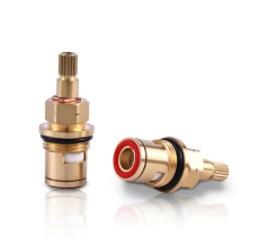In the intricate world of fluid control systems, the choice between the Ceramic Valve Core and Metal Valve Core is a critical decision that can significantly impact the performance, longevity, and reliability of a system. Both types of valve cores have been widely utilized across various industries, each boasting its own set of advantages and disadvantages. This article delves into the comparison of Ceramic Valve Cores and Metal Valve Cores, examining their respective merits and shortcomings in detail.
Ceramic Valve Cores, known for their exceptional hardness and resistance to wear, offer a compelling alternative to traditional metal valve cores. The use of advanced ceramic materials in valve cores has been a game-changer in applications where high-pressure and abrasive fluids are involved. The hardness of Ceramic Valve Cores, which is significantly higher than that of most metals, results in a longer service life and reduced maintenance requirements. This is particularly beneficial in harsh environments where metal components may succumb to wear and tear more quickly.
Another advantage of Ceramic Valve Cores is their corrosion resistance. Unlike metal valve cores, which can be susceptible to chemical reactions with certain fluids, Ceramic Valve Cores maintain their integrity even in the presence of corrosive substances. This property is invaluable in industries such as chemical processing, where the valve cores may be exposed to a variety of aggressive chemicals.
However, Ceramic Valve Cores are not without their drawbacks. One of the primary concerns with ceramic materials is their brittleness. While they are highly resistant to wear, they can be prone to fracture under sudden impact or extreme thermal shock. This characteristic necessitates careful handling and consideration of the operating environment when using Ceramic Valve Cores.
On the other hand, Metal Valve Cores have been the industry standard for many years, offering a balance of properties that make them suitable for a wide range of applications. Metal valve cores are generally more ductile and less prone to fracture than their ceramic counterparts. This ductility allows metal valve cores to absorb impact without breaking, providing a level of safety and reliability in applications where sudden changes in pressure or temperature may occur.
Furthermore, Metal Valve Cores are typically more cost-effective than Ceramic Valve Cores. The manufacturing process for metal components is often more streamlined and less expensive, making metal valve cores an attractive option for applications where budget constraints are a concern.
However, the susceptibility of Metal Valve Cores to corrosion and wear is a significant drawback. In environments where corrosive fluids are present, metal valve cores may require more frequent replacement or additional protective coatings, adding to the overall cost of ownership.
In conclusion, the choice between Ceramic Valve Cores and Metal Valve Cores depends on the specific requirements of the application. Ceramic Valve Cores offer superior wear resistance and corrosion resistance, making them ideal for harsh environments and applications involving abrasive or corrosive fluids. However, their brittleness and higher cost may be a concern for some users. Metal Valve Cores, while more susceptible to wear and corrosion, provide a balance of ductility, cost-effectiveness, and ease of manufacturing that makes them a viable option for many applications. Ultimately, the decision should be based on a thorough evaluation of the operating conditions, fluid properties, and budgetary considerations.


